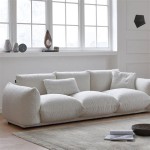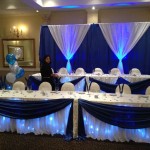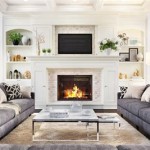Elevating Your Space: Home Decor Ideas for Bookshelves
Bookshelves, long relegated to the functional storage of literary works, have evolved into powerful elements of home decor. They offer opportunities to showcase personality, curate collections, and add visual interest to any room. Beyond simply housing books, well-styled bookshelves can significantly enhance the overall aesthetic of a space, transforming it from utilitarian to sophisticated. The key to achieving this transformation lies in understanding the fundamentals of bookshelf styling and applying them in a thoughtful and deliberate manner.
The process of decorating bookshelves involves more than just placing items haphazardly. It requires considering factors such as color palettes, textures, spatial arrangement, and the relationship between the bookshelf and its surrounding environment. Effective bookshelf decor creates a balanced and visually appealing display that reflects individual tastes and complements the existing interior design. This article explores practical strategies for transforming ordinary bookshelves into captivating focal points, providing insights into maximizing their decorative potential.
Balancing Functionality and Aesthetics
One of the most crucial aspects of bookshelf decor is finding the right balance between functionality and aesthetics. While the primary purpose of a bookshelf is to store books, it should also serve as an attractive display area. This balance can be achieved by strategically integrating decorative items among the books, creating visual interest and preventing the bookshelf from appearing overly cluttered or purely utilitarian.
Prioritizing books is essential. Start by arranging the books in a way that is both visually pleasing and easily accessible. Books can be organized by color, size, or genre to create a sense of order and harmony. Consider incorporating decorative bookends to add a touch of personality and prevent books from toppling over. Varying the orientation of the books, such as stacking some horizontally and standing others vertically, can also enhance visual appeal.
Once the books are arranged, the next step is to introduce decorative items that complement the collection. These items should be chosen carefully to reflect individual tastes and the overall style of the room. Consider incorporating items such as vases, picture frames, sculptures, plants, and decorative boxes. These elements add texture, color, and visual interest to the bookshelf, transforming it from a storage unit into a curated display.
The key to maintaining the balance between functionality and aesthetics is to avoid overcrowding the bookshelf. Leave empty spaces to allow the eye to rest and prevent the display from feeling cluttered. The amount of empty space will depend on the overall style of the room and individual preferences. A minimalist aesthetic may call for more open space, while a more eclectic style may allow for a denser arrangement of items.
Consider the weight and stability of items placed on the shelves. Heavier items should be placed on lower shelves to prevent the bookshelf from becoming unbalanced. Ensure that all items are securely positioned to avoid accidents or damage.
Ultimately, achieving the right balance between functionality and aesthetics requires experimentation and a willingness to adjust the arrangement until it feels harmonious and visually appealing. The goal is to create a bookshelf that is both practical and beautiful, reflecting individual style and enhancing the overall ambiance of the room.
Incorporating Color, Texture, and Pattern
The strategic use of color, texture, and pattern is fundamental to creating visually compelling bookshelf decor. These elements add depth, dimension, and personality to the display, transforming a simple storage unit into a captivating focal point. Thoughtful consideration of these elements is essential for achieving a cohesive and aesthetically pleasing bookshelf arrangement.
Color plays a significant role in creating visual harmony. Start by establishing a color palette that complements the existing decor of the room. This could involve selecting colors that are already present in the room's furniture, artwork, or wall color. Consider using a monochromatic color scheme for a sophisticated and understated look, or opt for a complementary color scheme to create a bolder and more dynamic effect. The color of the books themselves will contribute to the overall color palette, so this should be taken into account when selecting decorative items.
Texture adds depth and interest to the bookshelf arrangement. Incorporate items with varying textures to create a tactile and visually engaging display. Consider using natural materials such as wood, stone, and woven baskets to add warmth and organic texture. Metallic accents, such as brass or copper frames, can provide a touch of glamour and sophistication. The contrast between smooth and rough textures can also be used to create visual interest and prevent the bookshelf from feeling flat or monotonous.
Pattern can be used to add visual excitement and personality to the bookshelf. Consider incorporating items with geometric patterns, floral prints, or abstract designs. Patterns can be introduced through decorative boxes, picture frames, or even the book covers themselves. Be mindful not to overdo it with patterns, as too much can create a busy and overwhelming effect. Balance patterned items with solid-colored pieces to create a sense of visual equilibrium.
The interplay of color, texture, and pattern can be further enhanced by considering the lighting in the room. Natural light can accentuate textures and colors, while artificial light can be used to create dramatic effects. Consider adding a small lamp or string lights to the bookshelf to illuminate the display and create a warm and inviting ambiance.
Experimentation is key to finding the right combination of color, texture, and pattern for individual bookshelves. Try different arrangements and observe how the elements interact with each other. Pay attention to the overall visual impact and adjust the arrangement until it feels harmonious and visually appealing.
Creating Visual Hierarchy and Focal Points
Effective bookshelf styling involves creating a visual hierarchy that guides the viewer's eye and establishes clear focal points. This can be achieved through strategic placement of items, variation in height and scale, and the use of contrasting colors and textures. A well-defined visual hierarchy ensures that the bookshelf is not only aesthetically pleasing but also engaging and memorable.
Focal points are the areas of the bookshelf that immediately capture the viewer's attention. These can be created by placing larger, more visually striking items in prominent positions. For example, a large decorative vase, a framed piece of art, or a sculptural object can serve as a focal point. The placement of focal points should be strategic, taking into account the overall balance and symmetry of the bookshelf.
Once the focal points are established, the remaining items should be arranged in a way that supports and complements them. This involves creating a sense of visual flow, leading the eye from one focal point to another. This can be achieved by gradually reducing the size and scale of the items as they move away from the focal points. Consider using vertical stacking to add height and create a sense of drama, while horizontal arrangements can provide a sense of stability and grounding.
Varying the height and scale of items is essential for creating visual interest and preventing the bookshelf from appearing monotonous. Avoid placing items of the same height next to each other, as this can create a flat and uninspired look. Instead, mix and match items of different sizes and shapes to create a dynamic and engaging display. Consider using risers or stacks of books to elevate smaller items and add height to the arrangement.
The use of contrasting colors and textures can also be used to create visual hierarchy and draw attention to specific areas of the bookshelf. Pair light-colored items with dark-colored items to create a sense of contrast and highlight their individual features. Similarly, combine smooth textures with rough textures to add depth and visual interest. The contrast between different materials can be used to create a more dynamic and engaging display.
The arrangement of items on the bookshelf should be considered in relation to the surrounding environment. Take into account the height of the room, the size of the bookshelf, and the overall style of the decor. The bookshelf should complement the existing aesthetic and not compete with other elements in the room. The goal is to create a cohesive and harmonious space that reflects individual style and enhances the overall ambiance of the room.
Effective bookshelf decor is an ongoing process that requires experimentation and refinement. It is essential to regularly reassess the arrangement and make adjustments as needed. Consider rotating items seasonally or as individual tastes evolve.

9 Foolproof Bookshelf Decorating Ideas

20 Chic Bookshelf Decorating Ideas How To Decorate Bookshelves

Bookshelf Paint Ideas And Inspiration Architectural Digest

Shelf Styling Inspiration Decor Living Room Shelves House Interior

How To Decorate Bookshelves Green With Decor

Latest Bookshelf Decor Ideas For Your Home Design Cafe

Bookcase Styling Essential Pieces For A New Look Jenny Reimold Shelf Decor Living Room Decorating Bookshelves Home

10 Ways To Decorate And Style Your Bookcase Jennifer Maune

Bookshelf And Wall Shelf Decorating Ideas

How To Decorate Bookshelves Green With Decor







